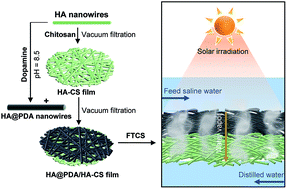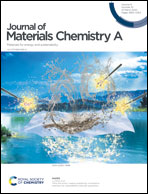Polydopamine/hydroxyapatite nanowire-based bilayered membrane for photothermal-driven membrane distillation†
Abstract
In developing countries and resource-limited regions, where no power infrastructure or waste heat from industrial plants is available, photothermal-driven membrane distillation (PMD) has been recognized as an attractive and sustainable technology for freshwater generation. PMD enables easy water collection, inherent fouling resistance, low-pressure operation, and high-salinity water treatment. Hydroxyapatite (HA) nanowires with excellent mechanical flexibility owing to their high aspect ratio, low thermal conductivity, easy surface modification and scalable production offer great potential for highly efficient membrane distillation. Herein, we demonstrate that the environmentally benign HA nanowire-based bilayered film offers the highest photothermal efficiency (62%) and water flux (0.89 kg m−2 h−1) with 1 sun irradiation (1 kW m−2), among the existing PMD systems without auxiliary heating or multilayer heat recovery reported so far. The hierarchical porous structure formed by the remarkably flexible and intertwined HA nanowires allows low resistance to vapor transport, which is critical for high water flux. Simultaneously, the low thermal conductivity of the thermal insulator layer comprised of HA nanowires prevents conductive heat transfer across the membrane, which significantly enhances the thermal efficiency of the membrane. The completely biocompatible, scalable, and thermally engineered bilayered film demonstrated here achieves highly efficient PMD.

- This article is part of the themed collection: Celebrating International Women’s Day: Women in Materials Science


 Please wait while we load your content...
Please wait while we load your content...
